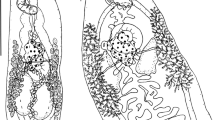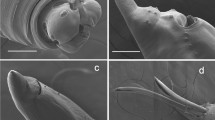Abstract
We describe the gastrointestinal helminth fauna of true lemmings (Lemmus spp., Arvicolinae) based on published and original material throughout the Holarctic range of these hosts. According to the existing data, the helminth fauna of true lemmings consists of three widespread and/or locally common taxa: Hymenolepis horrida (sensu lato) (Hymenolepididae), Anoplocephaloides lemmi (Anoplocephalidae) and Heligmosomoides spp. (Heligmosomidae). Despite the taxonomic boundaries and ancient phylogenetic splits in the hosts, there are no major faunistic differences for parasites within western (Siberian) L. sibiricus and L. bungei, and eastern (North American) L. trimucronatus throughout their distribution range. In contrast, the Norwegian lemming L. lemmus, which is a Fennoscandian endemic and closely related to the western populations of L. sibiricus, has only a single host-specific helminth, the cestode Paranoplocephala fellmani n. sp. (Anoplocephalidae). We describe the new species and show that it differs consistently from related species by its long and slender cirrus-sac. However, there are also a number of other significant differences, e.g., P. fellmani n. sp. and Andrya primordialis in Tamiasciurus hudsonicus (Sciuridae) evidently have a unique (sub)type of uterine development among Andrya/Paranoplocephala spp. Because P. fellmani n. sp. was also found to occur in Alaska (host L. trimucronatus), this species seems to follow the same biogeographical pattern as the other specialist helminths of Lemmus. We suggest alternative explanations for the absence of three major helminth taxa in the Norwegian lemming in Fennoscandia.
Similar content being viewed by others
References
Baruš, V., Tenora, F. & Wiger, R. (1977) Further occurence of some helminths in Rodentia and Insectivora from Fennoscandia. Folia Parasitologica, 24, 127-128.
Batzli, G. O. (1993) Food selection by lemmings. In: Stenseth, N.C. & Ims, R.A. (Eds) The biology of lemmings. London: Academic Press, pp. 281-301.
Baverstock, P.R., Adams, M. & Beveridge, I. (1985) Biochemical differentiation in bile duct cestodes and their marsupial hosts. Molecular Biology and Evolution, 2, 321-337.
Bondrup-Nielsen, S. (1993) Food preference and diet of the wood lemming (Myopus schisticolor). In: Stenseth, N.C. & Ims, R.A. (Eds) The biology of lemmings. London: Academic Press, pp. 303-309.
Brooks, D.R. & McLennan, D.A. (1993) Parascript. Parasites and the language of evolution. Washington and London: Smithsonian Institution Press, 429 pp.
Chilton, N.B., Andrews, R.H. & Beveridge, I. (1996) Genetic evidence for a complex of species within Rugopharynx australis (Mönnig, 1926) (Nematoda: Strongyloidea) from macropodid marsupials. Systematic Parasitology, 34, 125-133.
Douthitt, H. (1915) Studies on the cestode family Anoplocephalidae. Illinois Biological Monographs, 1, 1-96.
Durette-Desset, M.-C. (1968) Les systèmes d'arêtes cuticulaires chez les Nématodes Héligmosomes. III.-Étude de sept espèces parasites de Rongeurs néarctiques et rétablissement du genre Heligmosomoides Hall, 1916. Bulletin du Muséum National d'Histoire Naturelle, Série 2, 40, 186-209.
Fair, J.M., Schmidt, G.D. & Wertheim, G. (1990) New species of Andrya and Paranoplocephala from voles and mole-rats in Israel and Syria. Journal of Parasitology, 76, 641-644.
Fedorov, V., Goropashnaya, A., Jarrell, G.H. & Fredga, K. (1999) Phylogeographic structure and mitochondrial DNA variation in true lemmings (Lemmus) from the Eurasian Arctic. Biological Journal of the Linnean Society, 66, 357-371.
Fellman, J. (1848) Bidrag till Lappmarkens fauna. Suomi, 7, 213-283.
Framstadt, E., Stenseth, N.C. & Østbye, E. (1993) Demography of Lemmus lemmus through five population cycles. In: Stenseth, N.C. & Ims, R.A. (Eds) The biology of lemmings. London: Academic Press, pp. 117-133.
Fredga, K., Fedorov, V., Jarrell, G. & Jonsson, L. (1999) Genetic diversity in Arctic lemmings. Ambio, 28, 261-269.
Genov, T., Vasileva, G.P. & Georgiev, B.B. (1996) Paranoplocephala aquatica n. sp. (Cestoda, Anoplocephalidae) from Arvicola terrestris and Ondatra zibethica (Rodentia), with redescriptions and comments on related species. Systematic Parasitology, 34, 135-152.
Gubanov, N.M. & Fedorov, K.P. (1967) [New species of helminths of Muridae from Yakutia.] Materialy k Nauchnoj Konferencii Vsesojuznogo Obschestva Gel'mintologov, 5, 11-126. (In Russian).
Gubanov, N.M. & Fedorov, K.P. (1970) [Helminth fauna of Muridae of Yakutia]. In: Fauna Sibirii. Novosibirsk: Nauka, pp. 18-47. (In Russian).
Gulyaev, V.D. & Chechulin, A.I. (1997) Arostrilepis microtis n. sp. (Cyclophyllidea: Hymenolepididae), a new cestode species from Siberian rodents. Research and Reviews in Parasitology, 57, 103-107.
Haukisalmi, V. (1986) Frequency distributions of helminths in microtine rodents in Finnish Lapland. Annales Zoologici Fennici, 23, 141-150.
Haukisalmi, V. & Henttonen, H. (1993) Coexistence in helminths of the bank vole Clethrionomys glareolus. I. Patterns of cooccurrence. Journal of Animal Ecology, 62, 221-229.
Haukisalmi, V. & Henttonen, H. (2000) Description and morphometric variability of Paranoplocephala serrata n. sp. (Cestoda: Anoplocephalidae) in collared lemmings (Dicrostonyx spp., Arvicolinae) from Arctic Siberia and North America. Systematic Parasitology, 45, 219-231.
Haukisalmi, V., Henttonen, H. & Pietiäinen, H. (1994) Helminth parasitism does not increase the vulnerability of the field vole Microtus agrestis to predation by the Ural owl Strix uralensis. Annales Zoologici Fennici, 31, 263-269.
Haukisalmi, V., Henttonen, H. & Tenora, F. (1987) Parasitism by helminths in the grey-sided vole (Clethrionomys rufocanus) in northern Finland: influence of density, habitat and sex of the host. Journal of Wildlife Diseases, 23, 233-241.
Haukisalmi, V., Henttonen, H. & Tenora, F. (1988) Population dynamics of common and rare helminths in cyclic vole populations. Journal of Animal Ecology, 57, 807-825.
Henttonen, H. & Kaikusalo, A. (1993) Lemming movements. In: Stenseth, N.C. & Ims, R.A. (Eds) The biology of lemmings. London: Academic Press, pp. 157-211.
Hoberg, E.P. (1995) Historical biogeography and modes of speciation across high latitude seas of the holarctic — concepts for host-parasite coevolution among the Phocini (Phocidae) and Tetrabothriidae (Eucestoda). Canadian Journal of Zoology, 73, 45-57.
Hoberg, E.P., Monsen, K.J., Kutz, S. & Blouin, M.S. (1999) Structure, biodiversity, and historical biogeography of nematode faunas in Holarctic ruminants: morphological andmolecular diagnoses for Teladorsagia boreoarcticus n. sp. (Nematoda: Ostertagiinae), a dimorphic cryptic species in muskoxen (Ovibos moschatus). Journal of Parasitology, 85, 910-934.
Hoberg, E.P., Polley, L., Gunn, A. & Nishi, J.S. (1995) Umingmakstrongylus pallikuukensis gen. nov. et sp. nov. (Nematoda: Protostrongylidae) from muskoxen, Ovibos moschatus, in the central Canadian Arctic, with comments on biology and biogeography. Canadian Journal of Zoology, 73, 2266-2282.
Jarrell, G.H. & Fredga, K. (1993) How many kinds of lemmings? A taxonomic overview. In: Stenseth, N.C. & Ims, R.A. (Eds) The biology of lemmings. London: Academic Press, pp. 45-57.
Kirshenblat, Ya. D. (1941) [New tapeworm from the Transcaucasian voles.] Soobscheniya Akademii Nauk Gruzinskoj SSR, 2, 273-276. (In Russian).
Kontrimavichus, V.L. & Smirnova, L.V. (1991) [Hymenolepis beringiensis n. sp. of Siberian lemmings (Lemmus sibiricus Kerr) and problems of twin species in helminthology.] In: Krasnoshchekov, G.P., Roitman, V.A., Sonin, M.D. & Chesnova, L.V. (Eds) Evoljutsija parazitov. Materialy pervogo vsesojuznogo simpoziuma. Tol'yatti: Akademiya Nauk SSSR, pp. 90-104. (In Russian).
Kowalski, K. (1995) Lemmings (Mammalia, Rodentia) as indicators of temperature and humidity in the European Quaternary. Acta Zoologica Cracoviensia, 38, 85-94.
Luzhkov, A.D. (1964) [Parasitic worms of lemmings and voles of the Yamal peninsula.] Materialy k Nauchnoj Konferenchii Vsesojuznogo Obschestva Gel'mintologov, 1, 234-238. (In Russian).
Rausch, R. (1950) Observations on a cyclic decline of lemmings (Lemmus) on the Arctic coast of Alaska during the spring of 1949. Arctic, 3, 166-177.
Rausch, R.L. (1952) Studies on the helminth fauna of Alaska. XI. Helminth parasites of microtine rodents — taxonomic considerations. Journal of Parasitology, 38, 415-444.
Rausch, R.L. (1982) Cestodes in mammals: the zoogeography of some parasite-host assemblages. Mémoires du Muséum National d'Histoire Naturelle Paris, Série A, Zoologie, 123, 179-184.
Rausch, R.L. (1994) Transberingian dispersal of cestodes in mammals. International Journal for Parasitology, 24, 1203-1212.
Rausch, R.L. & Rausch, V.R. (1975) Taxonomy and zoogeography of Lemmus spp. (Rodentia: Arvicolinae), with notes on laboratory-reared lemmings. Zeitschrift für Säugetierkunde, 40, 8-34.
Revin, Yu.V. (1983) [Materials on the ecology of the Amur lemming (Lemmus amurensis) in South Yakutia.] Zoologicheskii Zhurnal, 62, 922-929. (In Russian).
Rudolphi, C.A. (1810) Entozoorum, sive vermium intestinalium historia naturalis. Amstelaedami: Tabernae Librariae et Artium, 386 pp.
Rudolphi, C.A. (1819) Entozoorum synopsis cui accedunt mantissa duplex et indices locupletissimi. Berolini: Augustus Rücker, 811 pp.
Ryzhikov, K.M., Gvozdev, E.V., Tokobaev, M.M., Shaldybin, L.S., Macaberidze, G.V., Merkusheva, I.V., Nadtochij, E.V., Hohlova, I.G. & Sharpilo, L.D. (1978) [Keys to the helminths of the rodent fauna of the USSR. Cestodes and trematodes.] Moskva: Nauka, 231 pp.
Ryzhikov, K.M., Gvozdev, E.V., Tokobaev, M.M., Shaldybin, L.S., Macaberidze, G.V., Merkusheva, I.V., Nadtochij, E.V., Hohlova, I.G. & Sharpilo, L.D. (1979) [Keys to the helminths of the rodent fauna of the USSR. Nematodes and acanthocephalans.] Moskva: Nauka, 272 pp. (In Russian).
Sato, H., Kamiya, H., Tenora, F. & Kamiya, M. (1993) Anoplocephaloides dentatoides sp. n. from the gray-backed vole, Clethrionomys rufocanus bedfordiae, in Hokkaido, Japan. Journal of the Helminthological Society of Washington, 60, 105-110.
Schiller, E.L. (1952) Studies on the helminth fauna of Alaska. X. Morphological variation in Hymenolepis horrida (von Linstow, 1901) (Cestoda: Hymenolepididae). Journal of Parasitology, 38, 554-568.
Shahmatova, V.I. & Yudina, S.A. (1989) [Helminths of Muridae of Tajmyra]. In: Fedorov, K.P. (Ed.) Ekologiya gel'mintov pozvonochnyh Sibiri. Novosibirsk: Nauka, pp. 145-178. (In Russian).
Tast, J. (1991) Will the Norwegian lemming become endangered if climate becomes warmer? Arctic and Alpine Research, 23, 53-60.
Tenora, F. (1996) Andrya communis Douthitt, 1915 (Anoplocephalidae), a parasite of Clethrionomys spp. (Arvicolidae) in the Nearctic region. Helminthologia, 33, 37-41.
Tenora, F., Henttonen, H. & Haukisalmi, V. (1983) On helminths of rodents in Finland. Annales Zoologici Fennici, 20, 37-45.
Tenora, F. & Murai, É. (1980) The genera Anoplocephaloides and Paranoplocephala (Cestoda) parasites of Rodentia in Europe. Acta Zoologica Academiae Scientiarum Hungaricae, 26, 263-284.
Tenora, F., Murai, É. & Vaucher, C. (1985) On some Paranoplocephala species (Cestoda: Anoplocephalidae) parasitizing rodents (Rodentia) in Europe. Parasitologica Hungarica, 18, 29-48.
Tenora, F., Murai, É. & Vaucher, C. (1986) On Andrya Railliet, 1893 and Paranoplocephala Lühe, 1910 (Cestoda, Monieziinae). Parasitologica Hungarica, 19, 43-75.
Tenora, F., Wiger, R. & Baruš, V. (1979) Seasonal and annual variations in the prevalence of helminths in a cyclic population of Clethrionomys glareolus. Holarctic Ecology, 2, 176-181.
Wickström, L., Hantula, J., Haukisalmi, V. & Henttonen, H. (2000) Genetic and morphometric variation in the circumpolar helminth parasite Andrya arctica (Cestoda, Anoplocephalidae) in relation to the divergence of its lemming hosts (Dicrostonyx spp.). Zoological Journal of the Linnean Society, (In Press).
Yushkov, V.F. (1995) [Fauna of the European North-East of Russia.] In: Gel'minty mlekopitayuschih. St. Petersburg: Rossijskaya Akademiya Nauk, 203 pp. (In Russian).
Author information
Authors and Affiliations
Rights and permissions
About this article
Cite this article
Haukisalmi, V., Henttonen, H. Biogeography of helminth parasitism in Lemmus Link (Arvicolinae), with the description of Paranoplocephala fellmani n. sp. (Cestoda: Anoplocephalidae) from the Norwegian lemming L. lemmus (Linnaeus). Syst Parasitol 49, 7–22 (2001). https://doi.org/10.1023/A:1010778504559
Issue Date:
DOI: https://doi.org/10.1023/A:1010778504559




